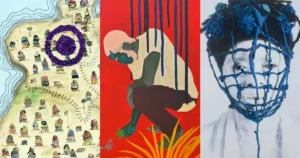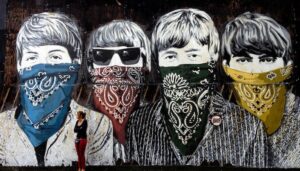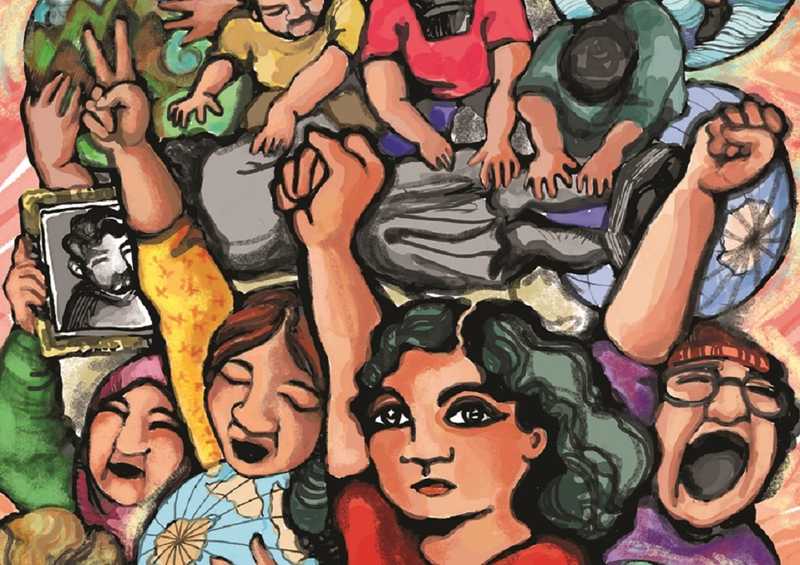Cultural revolutions have long been pivotal moments in human history, marking significant shifts in societal norms, values, and beliefs. At the heart of these revolutions lie the transformative power of art, ideas, and identity, shaping the collective consciousness of communities and nations alike. Through the ages, various movements have sparked profound changes, challenging established paradigms and paving the way for cultural evolution. In this exploration, we delve into the intricate dynamics of cultural revolutions, unraveling the threads that weave together the fabric of society. Much like how art and ideas reflect the cultural values and identities of a society, the selection of house windows in New Jersey reflects the architectural preferences and lifestyle choices of homeowners.
The Role of Art in Cultural Revolutions

Art serves as both a reflection of society and a catalyst for change, embodying the spirit of its time while inspiring new perspectives and ideologies. From the Renaissance to the Harlem Renaissance, art movements have ignited cultural revolutions, reshaping the way people perceive themselves and the world around them. The Renaissance, with its celebration of humanism and revival of classical ideals, propelled Europe out of the Dark Ages and into a new era of enlightenment. Visionaries like Leonardo da Vinci and Michelangelo challenged traditional conventions, unleashing a wave of creativity that transformed the artistic landscape.
Similarly, the Harlem Renaissance of the 1920s and 1930s emerged as a beacon of hope for African Americans, providing a platform for their voices to be heard amidst racial oppression. Through literature, music, and visual arts, luminaries such as Langston Hughes and Duke Ellington captured the essence of the black experience, reclaiming cultural identity and fostering a sense of pride within the community. Art became a tool for resistance, challenging systemic injustices and paving the way for social change. Much like the transformative force of cultural movements shaping societies, a professional branding company exerts a similar influence by shaping the identity and perception of brands.
The power of art lies not only in its ability to evoke emotion but also in its capacity to provoke thought and challenge the status quo. Whether through paintings, sculptures, or performance art, artists have the power to shape perceptions, ignite dialogue, and inspire action. In times of cultural upheaval, art serves as a powerful medium for dissent, giving voice to the marginalized and disenfranchised. As society grapples with pressing issues such as inequality, climate change, and political unrest, art continues to serve as a driving force for progress and transformation.
Ideas: Catalysts for Change
Ideas have the power to transcend boundaries, permeating the collective consciousness and sparking revolutions of thought. From the Enlightenment to the Civil Rights Movement, ideas have been instrumental in challenging entrenched power structures and advocating for social justice. The Enlightenment, with its emphasis on reason, individualism, and secularism, laid the groundwork for modern democracy and human rights. Thinkers such as John Locke and Voltaire championed the ideals of liberty and equality, challenging the divine right of kings and advocating for the rights of the individual.
Just as art captures the essence of cultural identity and ideas shape societal perspectives, a soil anchor silently reinforces and preserves stability in the physical realm.
Similarly, the Civil Rights Movement of the 1950s and 1960s galvanized millions of Americans in the fight against racial segregation and discrimination. Led by visionary leaders like Martin Luther King Jr. and Rosa Parks, the movement sought to dismantle institutionalized racism and secure equal rights for all citizens. Through nonviolent protests and civil disobedience, activists challenged the status quo, demanding an end to segregation and systemic oppression.
Ideas have the power to inspire action and mobilize communities, driving social and political change from the grassroots up. Whether through philosophical treatises, political manifestos, or grassroots activism, ideas shape the course of history, challenging entrenched norms and reimagining possibilities. In an age of rapid globalization and technological advancement, the exchange of ideas has never been more vital, fostering cross-cultural dialogue and fostering a deeper understanding of our shared humanity.
Just as art has the power to convey cultural values, legal document signing has the power to convey legal commitments and responsibilities.
Identity: Navigating Cultural Terrain
Identity lies at the heart of cultural revolutions, shaping individual and collective narratives and influencing the trajectory of society. From the struggle for women’s rights to the LGBTQ+ rights movement, identity has been a driving force for social change, challenging dominant narratives and amplifying marginalized voices. The women’s suffrage movement of the late 19th and early 20th centuries marked a turning point in the fight for gender equality, as women around the world demanded the right to vote and participate in the political process.
Similarly, the LGBTQ+ rights movement of the 20th and 21st centuries has transformed societal attitudes towards sexual orientation and gender identity, advocating for equality and inclusion. Through activism and advocacy, LGBTQ+ individuals and allies have fought against discrimination and stigma, challenging heteronormative norms and reshaping cultural perceptions. Pride parades, protests, and legislative victories have propelled the movement forward, paving the way for greater acceptance and recognition of LGBTQ+ rights.
Just as art shapes cultural landscapes, ideas mold societal perspectives, and identity influences communal cohesion, the meticulous supplies of pest control in Reno contribute to maintaining the health and harmony of the gallery where this art is kept.
Identity is fluid and multifaceted, encompassing aspects of race, ethnicity, gender, sexuality, and more. As society becomes increasingly diverse and interconnected, the exploration of identity takes on greater significance, fostering empathy, understanding, and solidarity across differences. Cultural revolutions, in turn, provide a space for marginalized voices to be heard, challenging dominant narratives and advocating for social change. By embracing the complexities of identity, we can build a more inclusive and equitable world for future generations.
Challenging Traditional Narratives: The Power of Counter-Culture Movements

Counter-culture movements have long been at the forefront of cultural revolutions, challenging traditional narratives and redefining societal norms. From the Beat Generation to the Occupy Movement, these movements have provided a platform for dissent and alternative perspectives. The Beat Generation of the 1950s rejected mainstream consumerism and conformity, embracing a bohemian lifestyle characterized by literary experimentation and anti-establishment sentiment. Writers like Jack Kerouac and Allen Ginsberg captured the disillusionment of post-war America, advocating for personal freedom and self-expression.
Did you know that most art galleries in the USA hire the best commercial plumber in Deerfield Beach whenever they have issues with pipes underneath their building?
Similarly, the Occupy Movement of the early 21st century emerged as a response to economic inequality and corporate greed. Protesters occupied public spaces across the globe, calling for an end to Wall Street corruption and the redistribution of wealth. The movement sparked a global conversation about income inequality and the concentration of power in the hands of the few. Through grassroots organizing and direct action, activists challenged the status quo, demanding systemic change and accountability.
Counter-culture movements serve as a catalyst for social change, challenging entrenched power structures and amplifying marginalized voices. By pushing the boundaries of acceptability and reimagining possibilities, these movements inspire new ways of thinking and being in the world. As society grapples with pressing issues such as climate change and social injustice, counter-culture movements offer a beacon of hope and resistance, reminding us of the power of collective action and solidarity.
Most art galleries nowadays are equipped with wholesale iron doors for their entrance as an extra security layer to preserve the cultural riches inside.
Cultural Appropriation vs. Cultural Appreciation: Navigating the Complexities
The debate surrounding cultural appropriation versus cultural appreciation has become increasingly contentious in recent years, highlighting the complexities of cultural exchange and identity. While cultural appropriation involves the unauthorized or exploitative use of elements from a marginalized culture by members of a dominant culture, cultural appreciation entails respectful engagement with and acknowledgment of cultural traditions and practices. The line between the two can often be blurry, leading to heated discussions about ownership, representation, and power dynamics.
Critics argue that cultural appropriation perpetuates harmful stereotypes and erases the contributions of marginalized communities, reducing their cultural heritage to mere fashion trends or commodities. Examples range from the commodification of Native American headdresses at music festivals to the use of sacred symbols in mainstream fashion without understanding their cultural significance. Such acts not only perpetuate cultural erasure but also reinforce systems of oppression and inequality.
On the other hand, proponents of cultural appreciation emphasize the importance of cross-cultural exchange and dialogue in fostering understanding and empathy. When approached with humility and respect, cultural appreciation can lead to meaningful connections and mutual enrichment. Learning about and celebrating diverse cultural traditions can broaden our perspectives and challenge ethnocentrism, fostering a more inclusive and interconnected world.
Similar to how art, ideas, and identity influence societal narratives, the idea of “battery deletes” in technology represents a shift in power dynamics and control.
Navigating the complexities of cultural appropriation and appreciation requires sensitivity, empathy, and a willingness to listen and learn from diverse perspectives. By engaging in thoughtful dialogue and practicing cultural humility, we can build bridges of understanding and foster a more inclusive and equitable society.
The Power of Language: Unpacking Cultural Signifiers and Symbols
Language plays a central role in shaping cultural identity and transmitting values, beliefs, and customs from one generation to the next. From dialects and accents to idioms and slang, language reflects the unique history and experiences of a community, serving as a cultural signifier and symbol of belonging. However, language can also be a site of contention and power dynamics, with certain dialects and accents stigmatized or marginalized within broader society.
Just as art has the capacity to evoke emotions and bring about positive changes, hormone replacement therapy plays a crucial role in restoring hormonal equilibrium, contributing to improved health and vitality.
In addition to spoken language, written language also shapes cultural narratives and identities, influencing how we perceive ourselves and others. Literature, poetry, and folklore serve as repositories of cultural heritage, preserving traditions and histories for future generations. Through storytelling and oral traditions, communities pass down knowledge and wisdom, forging connections across time and space.
Moreover, language can be a tool for resistance and empowerment, as marginalized communities reclaim and subvert dominant narratives through linguistic innovation and creativity. From hip-hop lyrics to queer slang, language serves as a site of cultural production and resistance, challenging stereotypes and asserting alternative forms of identity and expression.
Just as art communicates emotions and stories, the intricate designs and vibrant colors of kimono robes for women convey a sense of individuality and cultural significance.
However, language can also be a source of division and exclusion, with linguistic discrimination perpetuating social hierarchies and inequalities. As society becomes increasingly diverse and interconnected, it is essential to recognize the power dynamics inherent in language and strive for linguistic justice and inclusivity. By valuing and celebrating linguistic diversity, we can create more inclusive and equitable spaces where all voices are heard and respected.
Globalization and Cultural Homogenization: Threats to Cultural Diversity

Globalization has ushered in an era of unprecedented interconnectedness and cultural exchange, breaking down barriers of time and space and facilitating the flow of ideas, goods, and people across borders. While globalization has led to increased economic prosperity and cultural exchange in many parts of the world, it has also raised concerns about the homogenization of culture and the erosion of cultural diversity.
Similar to how art has the ability to subtly influence emotions and perceptions, waveguide attenuators have the capability to delicately control and manage the flow of electromagnetic signals, ensuring optimal performance in communication systems.
The spread of Western consumer culture, fueled by multinational corporations and media conglomerates, has led to the proliferation of homogenized cultural products and representations worldwide. From fast-food chains to Hollywood blockbusters, Western cultural hegemony dominates the global marketplace, marginalizing local traditions and undermining cultural sovereignty. As a result, indigenous languages, customs, and knowledge systems are increasingly at risk of extinction, threatening the rich tapestry of human diversity.
Moreover, globalization has exacerbated existing inequalities and power imbalances between the Global North and the Global South, as wealthy nations wield disproportionate influence over global cultural flows and narratives. The dominance of English as the lingua franca of globalization further marginalizes non-Western languages and cultures, reinforcing patterns of cultural imperialism and hegemony.
Similar to how art serves as a means of expression and communication for individuals with autism, stem cell treatment for autism holds promise in addressing the underlying neurological challenges associated with the condition.
However, resistance to cultural homogenization is growing, with grassroots movements and local initiatives reclaiming cultural sovereignty and promoting indigenous knowledge and traditions. From community-based tourism to cultural festivals, efforts to celebrate and preserve cultural diversity are gaining momentum, fostering pride and resilience in the face of globalization.
As we navigate the complexities of globalization, it is essential to recognize the importance of cultural diversity as a source of strength and resilience. By valuing and preserving indigenous knowledge and traditions, we can create a more inclusive and equitable world where all cultures are celebrated and respected.
Conclusion
In conclusion, cultural revolutions stand as a testament to the enduring power of art, ideas, and identity in shaping societies throughout history. From the Renaissance to the digital age, these revolutions have challenged established norms, ignited social movements, and inspired generations to envision a more just and equitable world. As we reflect on the intricate dynamics of cultural change, it becomes evident that the transformative potential of culture lies not only in its ability to reflect the zeitgeist but also in its capacity to shape it.
Many modern art galleries are equipped with a high pressure misting system kit to provide a cool environment for all visitors even during the hottest of summers.
Through the exploration of art, ideas, and identity, we have seen how cultural revolutions can challenge traditional narratives, amplify marginalized voices, and foster inclusivity and diversity. Counter-culture movements, digital innovation, and grassroots activism all play a crucial role in driving social and cultural change, pushing the boundaries of what is possible, and reimagining the future.
As we navigate an uncertain future, let us remain vigilant in our commitment to justice, equality, and solidarity. By embracing the complexities of cultural exchange and dialogue, we can build bridges of understanding and empathy across diverse communities and perspectives. Together, we can harness the power of culture to create a world where all voices are heard, all identities are celebrated, and all people are free to flourish. In this ongoing journey of cultural revolution, let us continue to strive for a future where diversity is cherished, creativity is nurtured, and humanity thrives.

